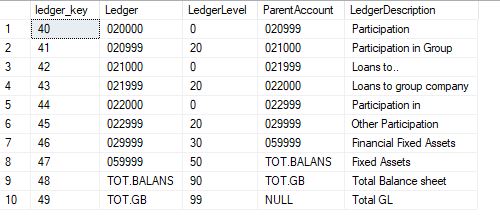We have a table LedgerAccount with the parent-child relationship as:
- CREATE TABLE [dbo].[LedgerAccounts](
- [ledger_key] [int] NOT NULL,
- [Ledger] [nvarchar](12) NULL,
- [LedgerLevel] [int] NULL,
- [ParentAccount] [nvarchar](12) NULL,
- [LedgerDescription] [nvarchar](30) NULL,
- CONSTRAINT [PK_LedgerAccount] PRIMARY KEY CLUSTERED
- (
- [ledger_key] ASC
- )WITH (PAD_INDEX = OFF, STATISTICS_NORECOMPUTE = OFF, IGNORE_DUP_KEY = OFF, ALLOW_ROW_LOCKS = ON, ALLOW_PAGE_LOCKS = ON) ON [PRIMARY]
- ) ON [PRIMARY]
-
-
- INSERT INTO [dbo].[LedgerAccounts]
- VALUES (40, '020000', 0, '020999', 'Participation'),
- (41, '020999', 20, '021000', 'Participation in Group'),
- (42, '021000', 0, '021999', 'Loans to..'),
- (43, '021999', 20, '022000', 'Loans to group company'),
- (44, '022000', 0, '022999', 'Participation in'),
- (45, '022999', 20, '029999', 'Other Participation'),
- (46, '029999', 30, '059999', 'Financial Fixed Assets'),
- (47, '059999', 50, 'TOT.BALANS', 'Fixed Assets'),
- (48, 'TOT.BALANS', 90, 'TOT.GB', 'Total Balance sheet'),
- (49, 'TOT.GB', 99, 'NULL', 'Total GL')

To create a table/view using the hierarchical relationship in the above table as:

The following query gives me the desired result but with static levels(for example let's say level 0 to 3).
How can I achieve the same without knowing the number of levels and levels id prior i.e. dynamically?
I am a newbie in SQL and have basic knowledge of it.
- create or alter view [dbo].[Ledgerview] as
WITH LedgerAccountstree AS
(
SELECT
ledger_key,
Ledger as CurrLedgerCode,
Ledger,
Ledger as Lvl0Code,
LedgerDescription as Lvl0Description,
cast('-' as nvarchar(12)) as Lvl1Code,
cast('-' as nvarchar(30)) as Lvl1Description,
cast('-' as nvarchar(12)) as Lvl2Code,
cast('-' as nvarchar(30)) as Lvl2Description,
cast('-' as nvarchar(12)) as Lvl3Code,
cast('-' as nvarchar(30)) as Lvl3Description,
ParentAccount,
LedgerLevel
FROM
[dbo].[LedgerAccounts]
WHERE
LedgerLevel = 50
UNION ALL
SELECT
[dbo].[LedgerAccounts].ledger_key,
LedgerAccountstree.CurrLedgerCode,
[dbo].[LedgerAccounts].Ledger,
LedgerAccountstree.Lvl0Code,
LedgerAccountstree.Lvl0Description,
case when [dbo].[LedgerAccounts].LedgerLevel = 30 then [dbo].[LedgerAccounts].Ledger else LedgerAccountstree.Lvl1Code end as Lvl1Code,
case when [dbo].[LedgerAccounts].LedgerLevel = 30 then [dbo].[LedgerAccounts].LedgerDescription else LedgerAccountstree.Lvl1Description end as Lvl1Description,
case when [dbo].[LedgerAccounts].LedgerLevel = 20 then [dbo].[LedgerAccounts].Ledger else LedgerAccountstree.Lvl2Code end as Lvl2Code,
case when [dbo].[LedgerAccounts].LedgerLevel = 20 then [dbo].[LedgerAccounts].LedgerDescription else LedgerAccountstree.Lvl2Description end as Lvl2Description,
case when [dbo].[LedgerAccounts].LedgerLevel = 0 then [dbo].[LedgerAccounts].Ledger else LedgerAccountstree.Lvl3Code end as Lvl3Code,
case when [dbo].[LedgerAccounts].LedgerLevel = 0 then [dbo].[LedgerAccounts].LedgerDescription else LedgerAccountstree.Lvl3Description end as Lvl3Description,
[dbo].[LedgerAccounts].ParentAccount,
[dbo].[LedgerAccounts].LedgerLevel
FROM
[dbo].[LedgerAccounts]
JOIN
LedgerAccountstree
ON LedgerAccountstree.Ledger = [dbo].[LedgerAccounts].[ParentAccount]
)
SELECT
ledger_key,
Ledger,
Lvl3Code +'-'+ Lvl3Description as Level0,
Lvl2Code +'-'+ Lvl2Description as Level1,
Lvl1Code +'-'+ Lvl1Description as Level2,
Lvl0Code +'-'+ Lvl0Description as Level3
FROM
LedgerAccountstree
GO

